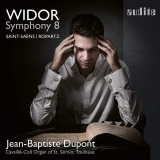 Charles-Marie Widor: Symphonie Nr. 8 H-Dur op. 42/4; Joseph-Guy Ropartz: Prière aus 6 Stücke für Orgel; Camille Saint-Saëns: Cyprès aus Zypressen und Lorbeer d-Moll op. 156; Jean-Baptiste Dupont, Orgel; 1 CD Audite 97.774; Aufnahme 11/2019, Veröffentlichung 03/2021 (54’34) - Rezension von Guy Engels
Charles-Marie Widor: Symphonie Nr. 8 H-Dur op. 42/4; Joseph-Guy Ropartz: Prière aus 6 Stücke für Orgel; Camille Saint-Saëns: Cyprès aus Zypressen und Lorbeer d-Moll op. 156; Jean-Baptiste Dupont, Orgel; 1 CD Audite 97.774; Aufnahme 11/2019, Veröffentlichung 03/2021 (54’34) - Rezension von Guy Engels
Mit Charles-Marie Widor begegnen wir auf dieser Aufnahme einem der Protagonisten der französischen Orgelsymphonik des 19. und 20. Jahrhunderts. Die Orgel hat gewissermaßen die Empore, den liturgischen Raum verlassen und sich als Konzertinstrument selbständig gemacht.
Viele Werke dieser Zeit wurden für die mächtigen Cavaillé-Coll-Orgeln geschrieben. Auf der Cavaillé-Coll-Orgel in Saint-Sernin in Toulouse entstand diese Aufnahme mit Jean-Baptiste Dupont.
Neben den rein technischen Fallstricken, die hinter der Orgel in Toulouse lauern – Jean-Baptiste Dupont beschreibt sie im Booklet – lauert ganz allgemein die Gefahr, sich von der Macht, der Klangwucht des Instruments verführen zu lassen.
Bei Jean-Baptiste Dupont muss man sich keine Sorgen machen. Er beherrscht das Instrument, nicht umgekehrt. Dupont schafft es, den ganz großen Bogen zu schlagen, von den initialen, mächtigen Akkorden bis hin zum festlichen Schluss.
Dazwischen liegen insgesamt sechs Sätze, die ein Füllhorn an Klangfarben und auch Emotionen bieten. Jean-Baptiste Dupont verführt uns mit poetischen Klängen im Moderato, zeigt sich leichtfüßig und verspielt im dritten Satz, unterstreicht seine Sensibilität für Formen und Stile in den Variationen des 4. Satzes.
Orgelsymphonien sind vielleicht nicht jedermanns Sache. Bei Jean-Baptiste Dupont ist man in guten Händen, sich auf differenzierte und einfühlsame Weise auf dieses spannende Repertoire einzulassen.
With Charles-Marie Widor we have one of the protagonists of French organ symphonic music of the 19th and 20th centuries. In a sense, the organ left the gallery, the liturgical space, and became independent as a concert instrument.
Many works of this period were written for the mighty Cavaillé-Coll organs. It was on the Cavaillé-Coll organ in Saint-Sernin in Toulouse that this recording was made with Jean-Baptiste Dupont.
Besides the purely technical pitfalls that lurk behind the organ in Toulouse – Jean-Baptiste Dupont describes them in the booklet – there is the general danger of being seduced by the power, the sonic force of the instrument.
With Jean-Baptiste Dupont, there is no need to worry. He dominates the instrument, not the other way around. Dupont manages to create the very big arch, from the initial, powerful chords to the festive conclusion.
In between are a total of six movements that offer a cornucopia of tonal colors and also emotions. Jean-Baptiste Dupont seduces us with poetic sounds in the Moderato, shows himself light-footed and playful in the third movement, underlines his sensitivity for forms and styles in the variations of the fourth movement.
Organ symphonies may not be everyone’s cup of tea. With Jean-Baptiste Dupont, one is in good hands to engage with this exciting repertoire in a differentiated and sensitive manner.
























